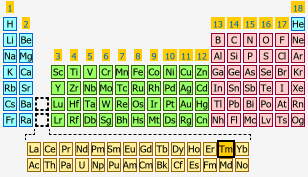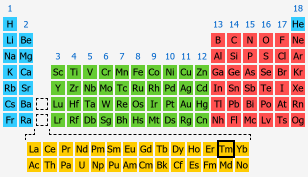References (Click the  next to a value above to see complete citation information for that entry)
next to a value above to see complete citation information for that entry)
Allred, A. L. "Electronegativity Values from Thermochemical Data." Journal of Inorganic and Nuclear Chemistry, volume 17, number 3-4, 1961, pp. 215–221. doi:10.1016/0022-1902(61)80142-5
Anders, Edward, and Nicolas Grevesse. "Abundances of the Elements: Meteoritic and Solar." Geochimica et Cosmochimica Acta, volume 53, number 1, 1989, pp. 197–214. doi:10.1016/0016-7037(89)90286-X
Ball, David W. "Elemental Etymology: What's in a Name?" Journal of Chemical Education, volume 62, number 9, 1985, pp. 787–788. doi:10.1021/ed062p787
Campbell, J. L. "Fluorescence Yields and Coster–Kronig Probabilities for
the Atomic L Subshells. Part II: The L1 Subshell Revisited." Atomic Data and Nuclear Data Tables, volume 95, number 1, 2009, pp. 115–124. doi:10.1016/j.adt.2008.08.002
Campbell, J. L. "Fluorescence Yields and Coster–Kronig Probabilities for
the Atomic L Subshells." Atomic Data and Nuclear Data Tables, volume 85, number 2, 2003, pp. 291–315. doi:10.1016/S0092-640X(03)00059-7
Cardarelli, François. Materials Handbook: A Concise
Desktop Reference, 2nd edition. London: Springer–Verlag, 2008.
Clementi, E., D. L. Raimondi, and W. P. Reinhardt. "Atomic Screening Constants from SCF Functions. II. Atoms with 37 to 86 Electrons." Journal of Chemical Physics, volume 47, number 4, 1967, pp. 1300–1307. doi:10.1063/1.1712084
Cohen, E. Richard, David R. Lide, and George L. Trigg, editors. AlP Physics Desk Reference, 3rd edition. New York: Springer-Verlag New York, Inc., 2003.
Connelly, Neil G., Ture Damhus, Richard M. Hartshorn, and Alan T. Hutton. Nomenclature of Inorganic Chemistry: IUPAC Recommendations 2005. Cambridge: RSC Publishing, 2005.
Cambridge: RSC Publishing, 2005.
Cordero, Beatriz, Verónica Gómez, Ana E. Platero-Prats, Marc Revés, Jorge Echeverría, Eduard Cremades, Flavia Barragán, and Santiago Alvarez. "Covalent Radii Revisited." Dalton Transactions, number 21, 2008, pp 2832–2838. doi:10.1039/b801115j
Cox, P. A. The Elements: Their Origin, Abundance and Distribution. Oxford: Oxford University Press, 1989.
Davis, V. T., and J. S. Thompson. "Measurement of the Electron Affinity of Thulium." Physical Review A, volume 65, number 1,
2001, pp. 010501–1 to 010501–3. doi:10.1103/PhysRevA.65.010501
de Podesta, Michael. Understanding the Properties of Matter, 2nd edition. London: Taylor & Francis, 2002.
Dronskowski, Richard. Computational Chemistry of Solid State Materials. Weinheim, Germany: WILEY-VCH Verlag GmbH & Co. KGaA, 2005.
Emsley, John. Nature's Building Blocks: An A-Z Guide to the Elements. Oxford: Oxford University Press, 2003.
Emsley, John. The Elements, 3rd edition. Oxford: Oxford University Press, 1998.
Firestone, Richard B. Table of Isotopes,
8th edition, volume 2. Edited by Virginia S. Shirley, with assistant editors Coral M. Baglin, S. Y. Frank Chu, and Jean Zipkin. New York: John Wiley & Sons, Inc., 1996.
Greenwood, N. N., and A. Earnshaw. Chemistry of the Elements, 2nd edition. Oxford: Butterworth-Heinemann, 1997.
Gwyn Williams. Electron Binding Energies. http://www.jlab.org/~gwyn/ebindene.html . Accessed on April 30, 2010.
. Accessed on April 30, 2010.
Ho, C. Y., R. W. Powell, and P. E. Liley. "Thermal Conductivity of the Elements: A Comprehensive Review." Journal of Physical and Chemical Reference Data, volume 3, supplement 1, 1974, pp. I–1 to I–796.
Journal of Physical and Chemical Reference Data, volume 3, supplement 1, 1974, pp. I–1 to I–796.
Horvath, A. L. "Critical Temperature of Elements and the Periodic System." Journal of Chemical Education, volume 50, number 5, 1973, pp. 335–336. doi:10.1021/ed050p335
Huheey, James E., Ellen A. Keiter, and Richard L Keiter. Inorganic Chemistry: Principles of Structure and Reactivity, 4th edition. New York: HarperCollins College Publishers, 1993.
Ihde, Aaron J. The Development of Modern Chemistry. New York: Dover Publications, Inc., 1984.
Jr., Elbert J. Little,, and Mark M. Jones. "A Complete Table of Electronegativities." Journal of Chemical Education, volume 37, number 5, 1960, pp. 231–233. doi:10.1021/ed037p231
Kittel, Charles. Introduction to Solid State Physics, 8th edition. Hoboken, NJ: John Wiley & Sons, Inc, 2005.
Konings, Rudy J. M., and Ondrej Beneš. "The Thermodynamic Properties of the f-Elements and Their Compounds. I. The Lanthanide and Actinide Metals." Journal of Physical and Chemical Reference Data, volume 39, number 4, 2010, pp. 043102–1 to 043102–47. doi:10.1063/1.3474238
Liboff, Richard L. Introductory Quantum Mechanics, 3rd edition. Reading, MA: Addison Wesley Longman, Inc., 1998.
Lide, David R., editor. CRC Handbook of Chemistry and
Physics, 88th edition. Boca Raton, Florida: Taylor & Francis Group, 2008.
Manuel, O., editor. Origin of Elements in the Solar System: Implications of Post-1957 Observations. New York: Kluwer Academic Publishers, 2000.
Marshall, James L. Discovery of the Elements: A Search for the Fundamental Principles of the Universe, 2nd edition. Boston, MA: Pearson Custom Publishing, 2002.
Martin, W. C. "Electronic Structure of the Elements." The European Physical Journal C — Particles and Fields, volume 15, number 1–4, 2000, pp. 78–79. doi:10.1007/BF02683401
Martin, W. C., Romuald Zalubas, and Lucy Hagan. Atomic
Energy Levels—The Rare-Earth Elements. Washington, D.C.: National Bureau of Standards, 1978.
McDonough, W. F. "Compositional Model for the Earth's Core." pp. 547–568 in The Mantle and Core. Edited by Richard W. Carlson. Oxford: Elsevier Ltd., 2005.
Mechtly, Eugene A. "Properties of Materials." pp. 4–1 to 4–33 in Reference Data For Engineers: Radio, Electronics, Computer, and Communications. By Mac E. Van
Valkenburg, edited by Wendy M. Middleton. Woburn, MA: Butterworth-Heinemann, 2002. doi:10.1016/B978-075067291-7/50006-6
Miessler, Gary L., and Donald A. Tarr. Inorganic Chemistry, 3rd edition. Upper Saddle River, NJ: Pearson Prentice Hall,
2004.
Nagle, Jeffrey K. "Atomic Polarizability and Electronegativity." Journal of the American Chemical Society, volume 112, number 12, 1990, pp. 4741–4747. doi:10.1021/ja00168a019
Orem, W. H., and R. B. Finkelman. "Coal Formation and Geochemistry." pp. 191–222 in Sediments, Diagenesis, and Sedimentary Rocks. Edited by Fred T. Mackenzie. Oxford: Elsevier Ltd., 2005.
Palme, H., and H. Beer. "Meteorites and the Composition of the Solar Photosphere." pp. 204–206 in Landolt–Börnstein—Group VI: Astronomy and Astrophysics. Edited by H. H. Voigt. New York: Springer–Verlag, 1993. doi:10.1007/10057790_59
Palme, H., and Hugh St. C. O'Neill. "Cosmochemical Estimates of Mantle Composition." pp. 1–38 in The Mantle and Core. Edited by Richard W. Carlson. Oxford: Elsevier Ltd., 2005.
Pauling, Linus. The Nature of the Chemical Bond, 3rd edition. Ithaca, NY: Cornell University Press, 1960.
Pekka Pyykkö. Self-Consistent, Year-2009 Covalent Radii. http://www.chem.helsinki.fi/~pyykko/Radii09.pdf . Accessed on November 20, 2010.
. Accessed on November 20, 2010.
Prohaska, Thomas, Johanna Irrgeher, Jacqueline Benefield, John K. Böhlke, Lesley A. Chesson, Tyler B. Coplen, Tiping Ding, Philip J. H. Dunn, Manfred Gröning, Norman E. Holden, Harro A. J. Meijer, Heiko Moossen, Antonio Possolo, Yoshio Takahashi, Jochen Vogl, Thomas Walczyk, Jun Wang, Michael E. Wieser, Shigekazu Yoneda, Xiang-Kun Zhu, and Juris Meija. "Standard Atomic Weights of the Elements 2021 (IUPAC Technical Report)." Pure and Applied Chemistry, volume 94, number 5, 2022, pp. 573–600. doi:10.1515/pac-2019-0603
Pure and Applied Chemistry, volume 94, number 5, 2022, pp. 573–600. doi:10.1515/pac-2019-0603
Pyykkö, Pekka, and Michiko Atsumi. "Molecular Double-Bond Covalent Radii for Elements Li-E112." Chemistry - A European Journal, volume 15, number 46, 2009, pp. 12770–12779. doi:10.1002/chem.200901472
Pyykkö, Pekka, and Michiko Atsumi. "Molecular Single-Bond Covalent Radii for Elements 1-118." Chemistry - A European Journal, volume 15, number 1, 2009, pp. 186–197. doi:10.1002/chem.200800987
Rohrer, Gregory S. Structure and Bonding in Crystalline Materials. Cambridge: Cambridge University Press, 2001.
Samsonov, G. V., editor. Handbook of the Physicochemical Properties of the Elements. New York: Plenum Publishing Corporation, 1968.
Sansonetti, J. E., and W. C. Martin. "Handbook of Basic Atomic Spectroscopic Data." Journal Of Physical And Chemical Reference Data, volume 34, number 4, 2005, pp. 1559–2259. doi:10.1063/1.1800011
Journal Of Physical And Chemical Reference Data, volume 34, number 4, 2005, pp. 1559–2259. doi:10.1063/1.1800011
Shannon, R. D. "Revised Effective Ionic Radii and Systematic Studies of Interatomic Distances in Halides and Chalcogenides." Acta Crystallographica Section A, volume 32, number 5, 1976, pp. 751–767. doi:10.1107/S0567739476001551
Silbey, Robert J., Robert A. Alberty, and Moungi G. Bawendi. Physical Chemistry, 4th edition. Hoboken, NJ: John Wiley & Sons, Inc., 2005.
Singman, Charles N. "Atomic Volume and Allotropy of the Elements." Journal of Chemical Education, volume 61, number 2, 1984,
pp. 137–142. doi:10.1021/ed061p137
Slater, J. C. "Atomic Radii in Crystals." The Journal of Chemical Physics, volume 41, number 10, 1964, pp. 3199–3204. doi:10.1063/1.1725697
Smith, Derek W. Inorganic Substances: A Prelude to the Study of Descriptive Inorganic Chemistry. Cambridge: Cambridge University Press, 1990.
Soukhanov, Anne H., editor. The American Heritage
Dictionary Of The English Language, 3rd edition. Boston: Houghton Mifflin Company, 1992.
Stewart, G. R. "Measurement of Low-Temperature Specific Heat." Review of Scientific Instruments, volume 54, number 1, 1983, pp. 1–11. doi:10.1063/1.1137207
Tari, A. The Specific Heat of Matter at Low Temperatures. London: Imperial College Press, 2003.
Vainshtein, Boris K., Vladimir M. Fridkin, and Vladimir L. Indenbom. Structure of Crystals, 2nd edition. Modern Crystallography 2. Edited by Boris K. Vainshtein, A. A. Chernov, and L. A. Shuvalov. Berlin: Springer-Verlag, 1995.
Voigt, H. H., editor. Landolt–Börnstein—Group VI
Astronomy and Astrophysics. Berlin: Springer–Verlag, 1993.
Waber, J. T., and Don T. Cromer. "Orbital Radii of Atoms and Ions." Journal of Chemical Physics, volume 42, number 12, 1965, pp. 4116–4123. doi:10.1063/1.1695904
Wagman, Donald D., William H. Evans, Vivian B. Parker, Richard H. Schumm, Iva Halow, Sylvia M. Bailey, Kenneth L. Churney, and Ralph L. Nuttall. "Thermal Conductivity of the Elements: A Comprehensive Review." Journal of Physical and Chemical Reference Data, volume 11, supplement 2, 1982, pp. 2–1 to 2–392.
Journal of Physical and Chemical Reference Data, volume 11, supplement 2, 1982, pp. 2–1 to 2–392.
Waldron, Kimberley A., Erin M. Fehringer, Amy E. Streeb, Jennifer E. Trosky, and Joshua J. Pearson. "Screening Percentages Based on Slater Effective Nuclear Charge as a Versatile Tool for Teaching Periodic Trends." Journal of Chemical Education, volume 78, number 5, 2001, pp. 635–639. doi:10.1021/ed078p635
Weeks, Mary Elvira, and Henry M. Leicester. Discovery of the Elements, 7th edition. Easton, PA: Journal of Chemical Education, 1968.
Yaws, Carl L. "Liquid Density of the Elements." Chemical
Engineering, volume 114, number 12, 2007, pp. 44–46.
Yaws, Carl L. The Yaws Handbook of Physical Properties for Hydrocarbons and Chemicals. Houston, TX: Gulf Publishing Company, 2005.























































 next to a value above to see complete citation information for that entry)
next to a value above to see complete citation information for that entry)





 Cambridge: RSC Publishing, 2005.
Cambridge: RSC Publishing, 2005.

 . Accessed on April 30, 2010.
. Accessed on April 30, 2010. Journal of Physical and Chemical Reference Data, volume 3, supplement 1, 1974, pp. I–1 to I–796.
Journal of Physical and Chemical Reference Data, volume 3, supplement 1, 1974, pp. I–1 to I–796.






 . Accessed on November 20, 2010.
. Accessed on November 20, 2010. Pure and Applied Chemistry, volume 94, number 5, 2022, pp. 573–600. doi:10.1515/
Pure and Applied Chemistry, volume 94, number 5, 2022, pp. 573–600. doi:10.1515/


 Journal Of Physical And Chemical Reference Data, volume 34, number 4, 2005, pp. 1559–2259. doi:10.1063/
Journal Of Physical And Chemical Reference Data, volume 34, number 4, 2005, pp. 1559–2259. doi:10.1063/





 Journal of Physical and Chemical Reference Data, volume 11, supplement 2, 1982, pp. 2–1 to 2–392.
Journal of Physical and Chemical Reference Data, volume 11, supplement 2, 1982, pp. 2–1 to 2–392.


